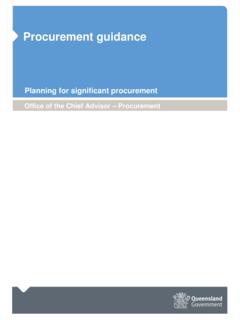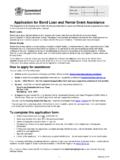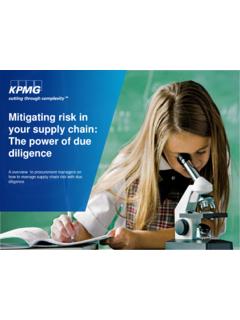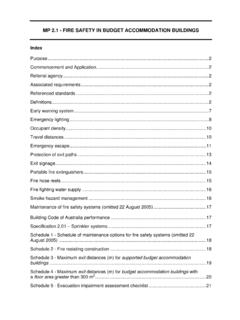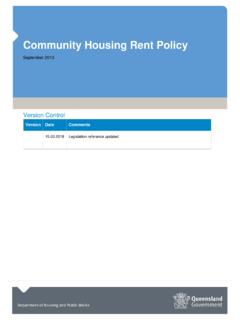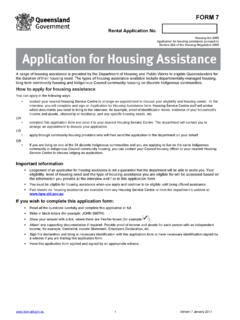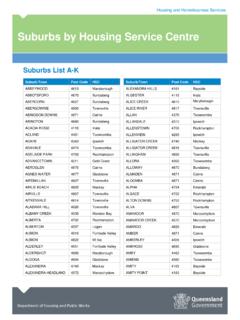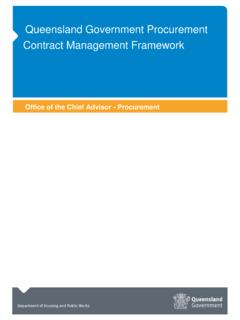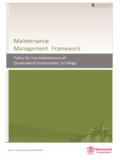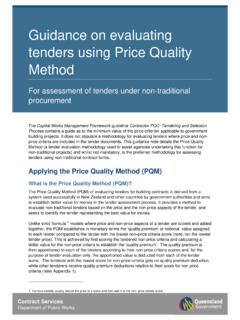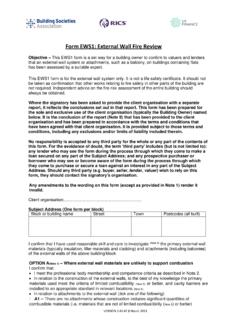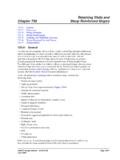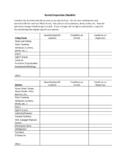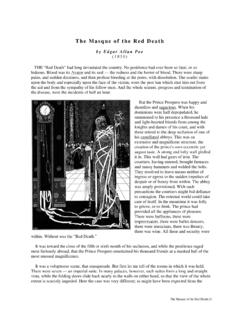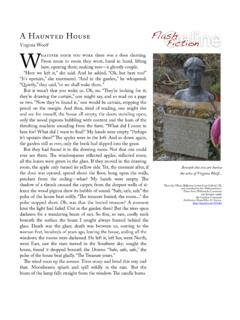Transcription of MP 4.4 Building in a transport noise corridor
1 MP BUILDINGS IN A transport noise corridor Queensland Development Code Page 1 MP Publication Date: 10 August 2010 Buildings in a transport noise corridor MP BUILDINGS IN A transport noise corridor Table of Contents Commencement .. 2 2 Referral 2 Associated Requirements .. 2 Referenced Documents .. 2 2 MP BUILDINGS IN A transport noise corridor Queensland Development Code Page 2 MP Publication Date: 10 August 2010 Buildings in a transport noise corridor Purpose To ensure habitable rooms of Class 1, 2, 3 and 4 buildings located in a transport noise corridor are designed and constructed to reduce transport noise . Commencement This version of Mandatory Part (MP) of the Queensland Development Code (QDC) commences on 1 September 2010. Application The part applies to Building work for the construction or renovation of a residential Building in a designated transport noise corridor . Referral Agency There is no referral agency for this part.
2 Associated Requirements (a) Building Act 1975 (b) Building Regulation 2006 (c) Building Code of Australia Referenced Documents Number Date Title AS/NZS 2107 2000 Acoustics Recommended design sound levels and reverberation times for Building interiors. AS 3671 1989 Acoustics Road traffic noise intrusion Building siting and construction. AS/NZS ISO 2004 Acoustics Rating of sound insulation in buildings and Building elements Airborne sound insulation. ISO (incorporating Amendment No. 1) 1995 Acoustics Measurement of sound insulation in buildings and of Building elements Part 3: Laboratory measurements of airborne sound insulation of Building elements. 2008 Road Traffic noise Management: Code of Practice (Department of transport and Main Roads). Version 2 2007 Code of Practice: Railway noise Management (Queensland Rail).
3 Definitions Note: Italicised words within the body of the text, other than legislation titles, are defined below. MP BUILDINGS IN A transport noise corridor Queensland Development Code Page 3 MP Publication Date: 10 August 2010 Buildings in a transport noise corridor Acceptable solution means a relevant Building solution which is deemed to satisfy the relevant performance requirement for the purposes of section 14 (4) (a) (ii) of the Building Act 1975. Acoustically rated plasterboard means plasterboard that has been measured to achieve an Rw in accordance with AS/NZS ISO Acoustically rated seals means seals that have been measured with a door to achieve an Rw in accordance with AS/NZS ISO Annual Average Daily Traffic (AADT) has the meaning given in section 246X(7) of the Building Act 1975. A-weighted sound pressure level is the level of the frequency weighted sound pressure determined in accordance with AS/NSZ 2107:2000.
4 BCA means the Building Code of Australia. dB(A) means decibels measured on the A weighting frequency. external envelope means the structural elements and components of a Building , including the roof, ceiling, walls and floors, which separate a habitable room from the exterior of the Building . Floor means a slab on ground or part of the external envelope which is elevated and exposed to the source of the transport noise , but does not include internal floors providing separation between individual sole-occupancy units or storeys. Habitable Room has the meaning given in the BCA. LA is the shortened form of A weighted sound pressure level as defined in AS/NZS 2107:2000. LA10, 18hr means the arithmetic average of the A-weighted sound pressure level that is exceeded for 10% of every hour over 18 consecutive hours between 6 am and 12 midnight. LA90,T means the A-weighted sound pressure level that is exceeded for 90 per cent of the measuring period (T).
5 LAeq, means an A-weighted sound pressure level of a continuous steady sound that within a measuring period has the same mean square sound pressure as a sound level that varies with time as defined in AS/NZS 2107:2000. LAmax means the maximum A-weighted sound pressure level during the nominated assessment period. Manufacturers specifications means specifications that that have been measured in accordance with AS/NZS ISO for a material or system and have been approved by a registered testing authority. MP BUILDINGS IN A transport noise corridor Queensland Development Code Page 4 MP Publication Date: 10 August 2010 Buildings in a transport noise corridor noise assessment means an acoustic report, prepared in accordance with Schedule 3, which identifies the noise category applicable to a Building or site based on site testing of acoustic properties. noise category means the category of transport noise that is applicable to a Building or site within a designated transport noise corridor , based on the amount of noise monitored or modeled for the location as indicated in: (a) State or Local Government records, as identified in a gazettal notice following designation of a transport noise corridor ; or Note: In cases where there is any inconsistency between current designations of transport noise corridors by different State and Local Government authorities, the higher of the noise categories applies.
6 Note: As soon as practicable after designating land as a transport noise corridor , a Local Government must include a record of the transport noise corridor in its planning scheme. Information is also held and is available for public enquiry in a State Government website. (b) a noise assessment prepared by a suitably qualified person. Planning scheme has the meaning given in the Sustainable Planning Act 2009. Railway land has the meaning given in the Building Act 1975. Registered testing authority has the meaning given in the BCA. Residential Building means a class 1, class 2, class 3 or class 4 Building as defined in the BCA. Rw means the weighted sound reduction index as specified in ISO 140-3. Single Event Maximum Level has the meaning given in Queensland Rail Limited s Code of Practice: Railway noise Management (2007) Version 2. State-controlled road has the meaning given in the transport Infrastructure Act 1994.
7 Suitably qualified person means a person who is assessed by a Building assessment manager to be a competent person in accordance with Part 5 of the Building Regulation 2006. transport noise means airborne noise originating from a transport noise corridor . transport noise reduction means the level of reduction of transport noise required from the fa ade of the Building to the internal environment, as identified in Schedule 1. Note: The predicted levels of transport noise reduction will be achieved only when doors, windows and other openings in the relevant parts of the Building s external envelope are closed. transport noise corridor means land designated under Chapter 8B of the Building Act 1975 as a transport noise corridor . MP BUILDINGS IN A transport noise corridor Queensland Development Code Page 5 MP Publication Date: 10 August 2010 Buildings in a transport noise corridor Note: This is identified in State and Local Government records as described in a gazettal notice following designation of the transport noise corridor .
8 MP BUILDINGS IN A transport noise corridor Queensland Development Code Page 6 MP Publication Date: 10 August 2010 Buildings in a transport noise corridor PERFORMANCE REQUIREMENTS ACCEPTABLE SOLUTIONS Residential buildings P1 Habitable rooms in residential buildings located in a transport noise corridor are adequately protected from transport noise to safeguard occupants health and amenity. A1 The external envelope of habitable rooms in a residential Building located in a transport noise corridor complies with the minimum RW for each Building component specified in Schedule 1 to achieve a minimum transport noise reduction level for the relevant noise category by: (a) using materials specified in Schedule 2; OR (b) using materials with manufacturer s specifications that, in combination, achieve the minimum Rw value for the relevant Building component and applicable noise category.
9 MP BUILDINGS IN A transport noise corridor Queensland Development Code Page 7 MP Publication Date: 10 August 2010 Buildings in a transport noise corridor Schedule 1 noise category Minimum transport noise reduction (dB (A)) required for habitable rooms Component of Building s external envelope Minimum Rw required for each component Glazing 43 external walls 52 Roof 45 Floors 51 Category 4 40 Entry doors 35 38 (where total area of glazing for a habitable room is greater than ) Glazing 35 (where total area of glazing for a habitable room is less than or equal to ) external walls 47 Roof 41 Floors 45 Category 3 35 Entry doors 33 MP BUILDINGS IN A transport noise corridor Minimum transport noise Component of Building s Minimum Publication Date.
10 10 August 2010 Buildings in a transport noise corridor noise category reduction (dB (A)) required for habitable rooms external envelope Rw required for each component 35 (where total area of glazing for a habitable room is greater than ) Glazing 32 (where total area of glazing for a habitable room is less than or equal to ) external walls 41 Roof 38 Floors 45 Category 2 30 Entry doors 33 27 (where total area of glazing for a habitable room is greater than ) Glazing 24 (where total area of glazing for a habitable room is less than or equal to ) external walls 35 Roof 35 Category 1 25 Entry Doors 28 Category 0 No additional acoustic treatment required standard Building assessment provisions apply.
